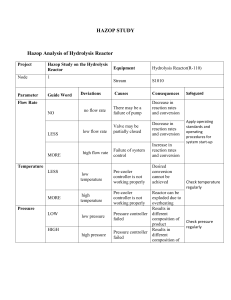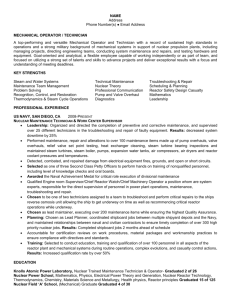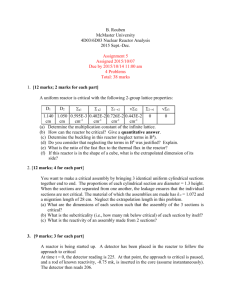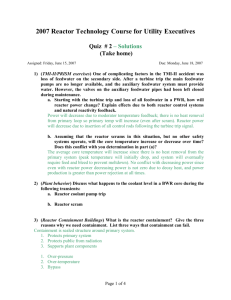CAPA Refresher: Corrective & Preventive Action in QMS
advertisement
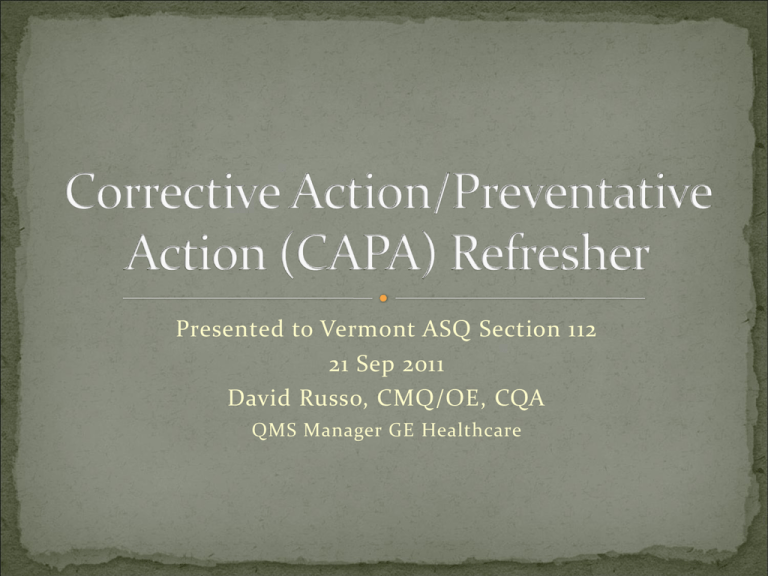
Presented to Vermont ASQ Section 112 21 Sep 2011 David Russo, CMQ/OE, CQA QMS Manager GE Healthcare ISO 9001 (13485): 8.5.2 “The organization shall take action to eliminate the cause of nonconformities in order to prevent recurrence.” CFR: 21 CFR 820.100 (Medical Device) “(a) Each manufacturer shall establish and maintain procedures for implementing corrective and preventive action” Unexpected, unwanted events with a Quality System. ASQ: The result of a nonfulfillment of a specified requirement. A mature CAPA system can serve as a useful tool for analyzing past events, correcting existing non conformities and preventing future events. A mature CAPA system goes beyond regulatory compliance to positively impact our customers by increasing the value of our products and services. Event-chain based NC investigation typically looks back at a series of adverse events to "assign blame" to a person or device Example; Three Mile Island (1979) Summary of Events The accident began about 4:00 a.m. on March 28, 1979, when the plant experienced a failure in the secondary, non-nuclear section of the plant. The main feed water pumps stopped running, caused by either a mechanical or electrical failure, which prevented the steam generators from removing heat. First the turbine, then the reactor automatically shut down. Immediately, the pressure in the primary system (the nuclear portion of the plant) began to increase. In order to prevent that pressure from becoming excessive, the pilotoperated relief valve (a valve located at the top of the pressurizer) opened. The valve should have closed when the pressure decreased by a certain amount, but it did not. Signals available to the operator failed to show that the valve was still open. As a result, cooling water poured out of the stuck-open valve and caused the core of the reactor to overheat. http://www.nrc.gov/reading-rm/doc-collections/fact-sheets/3mile-isle.html What happens when the system is at fault? Example: Consider an example of a industrial accident that occurred in a batch chemical reactor in England The computer was responsible for controlling the flow of catalyst into the reactor and also the flow of water into the reflux condenser to cool off the reaction. Additionally, sensor inputs to the computer were supposed to warn of any problems in various parts of the plant. The programmers were told that if a fault occurred in the plant, they were to leave all controlled variables as they were and to sound an alarm. On one occasion, the computer received a signal indicating a low oil level in a gearbox. The computer reacted as its requirements specified: It sounded an alarm and left the controls as they were. By coincidence, a catalyst had been added to the reactor, but the computer had just started to increase the cooling-water flow to the reflux condenser; the flow was therefore kept at a low rate. The reactor overheated, the relief valve lifted, and the contents of the reactor were discharged into the atmosphere Leveson, Nancy G. A New Accident Model for Engineering Safer Systems. SafetyScience, 42(4), April 2004, pp. 237–270) CAPA Process - structured, formalized way to investigate NC and determine appropriate corrections, corrective actions and preventative actions and measure their effectiveness. (With records) Each step can use quality tools to standardize the approach and document the outcomes. ISO 13485 and QSR require records of each step QMS has systems to detect NC Customer Complaints Equipment Monitoring Production Sampling Auditing Inspection Trending Accident Report Etc… Output = Specific Problem Statement Where, Who, Risk, Compliance? Is/Is Not Contradiction Matrix Expert Interviews Data/Trends Data/Records Timeline Evaluation rubric may be defined by your QMS (severity, probability of harm, $$ exposure) Keep records Determine what happened, how it happened, extent, identify true root cause(s) Seven classic quality tools (ASQ) Flowchart Checksheet Cause/Effect diagram (Ishikawa, fishbone) Pareto chart Control chart Histogram Scatter Diagram More tools 5-whys Is/Is-not Contradiction matrix Keep Records Lists corrective and preventive actions (if applicable)•Clearly addresses root causes Commensurate with the risk of the issue Where effectiveness checks are defined Identification of task owners and task due dates Implementation due date Keep records Action (Plastic part had air content over spec limit) C, CA, PA •Rewrite procedure for mold setup CA •Rewrite procedure for inspection process CA •Poke yoke process for ensuring proper ratio mix CA •Containment: identify potentially affected products and recall C •Error-proof the monitoring process CA •Design new products to not need air in the mold process PA Implementing a verified solution Testing during formation of action plan Validate Tracking (where, how many, who) Keep records Monitor performance indicators à compare “before” and “after” Achieve specific targets -- achieving a pre-determined PPM level Statistical Data Analysis-Performance must lie within a set of statistically derived control limits Emphasis should primarily be on identifying the most effective fix Verification and validation are completed prior to implementing the action Keep records 17 miles east of Sharon Springs, Kansas a loaded coal train from Denver to Chicago. A wheel bearing became overheated and melted off letting the truck support drop down and grind on top of the rail creating white hot molten metal droppings that spewed down onto the rails. The alert crew noticed a small amount of smoke halfway back in the train and immediately stopped the train in compliance with the rules.

